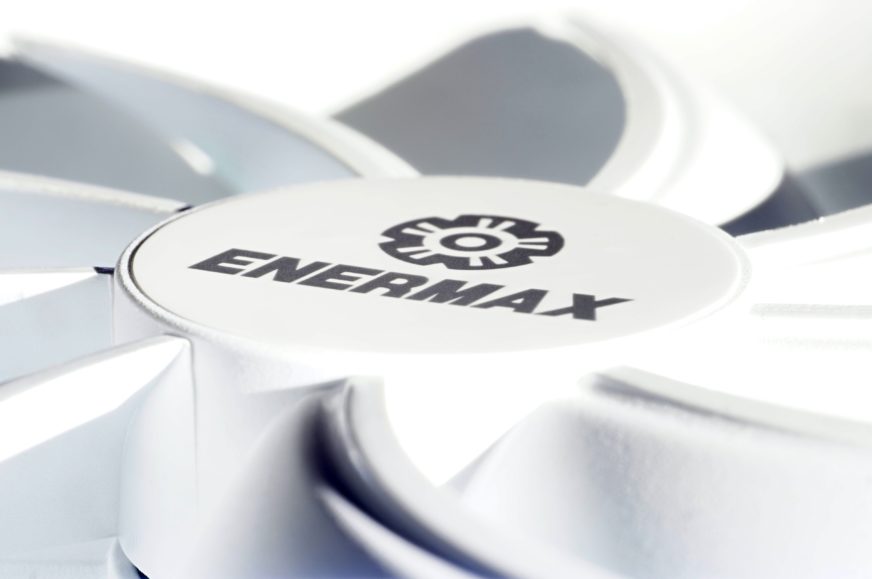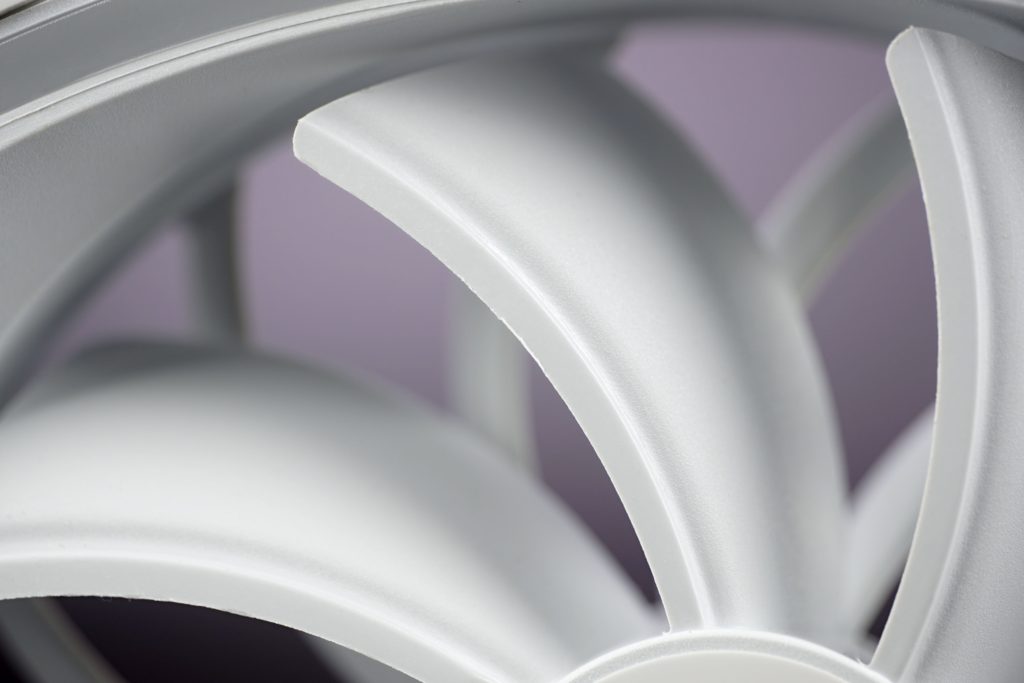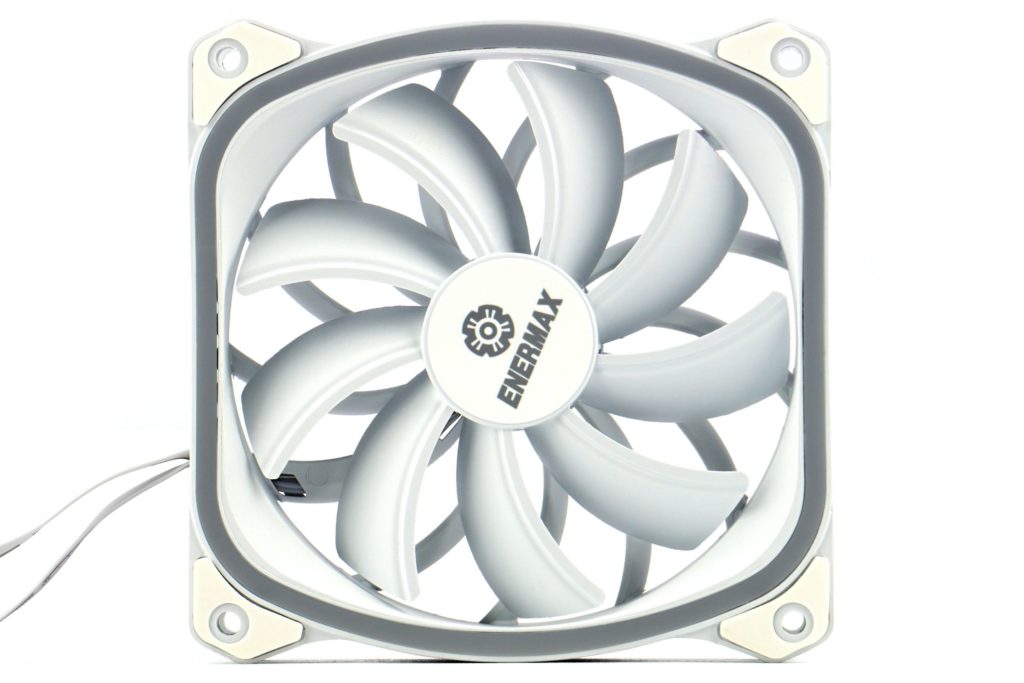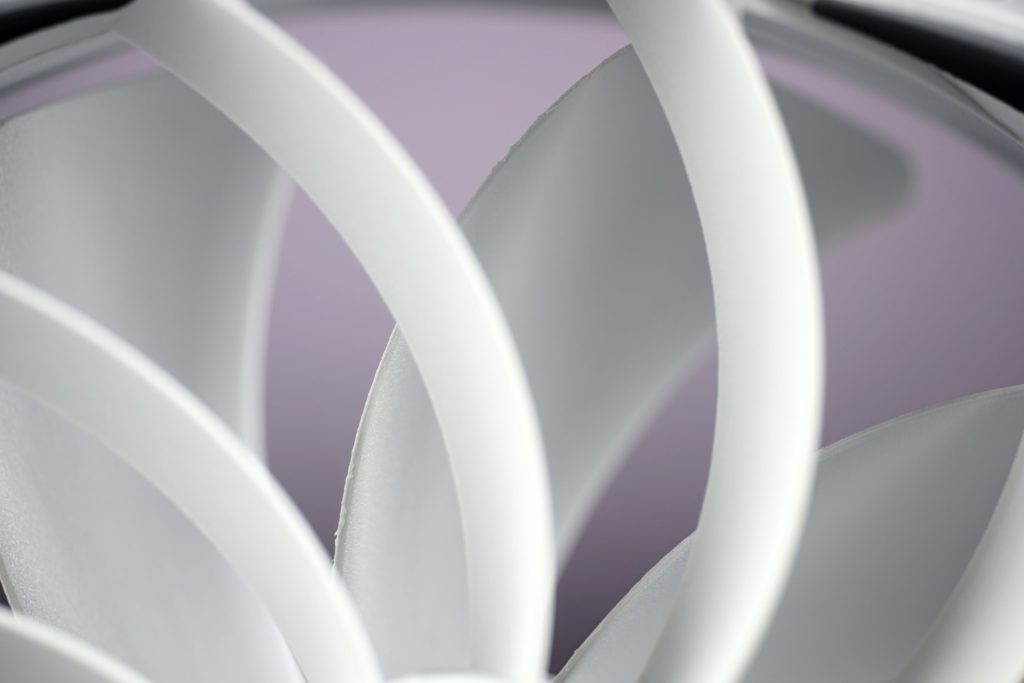Detaily Enermax SquA RGB White
Apart from the all-white design, which is rare in itself, this fan also stands out from the competition in other ways. Some of these need a cautionary finger raised, others deserve praise. Often for trying to differentiate themselves and even in a rather elegant, useful way. In the mix of everything about the SquA RGB fan, one can state its unique identity, for which it may win you over. But it also doesn’t have to.
White fans are slowly on the rise, but they are still (compared to black and overall dark variants) in a distinct minority. The SquA RGB White model, which we will now take a closer look at, is characterised by brightly coloured LED lighting in a rather original design. Technically, it is the type with a light guide around the rotor. However, it does not copy the circular shape of the rotor, as is common, Enermax has done it differently. Two sides of the light guide are straight, two are arcuate and are joined by rounded corners.
Quite uniquely, the RGB LED can also be alternatively powered by a 4-pin PWM connector. It is always better to use the dedicated 3-pin “ARGB” connector whenever possible, but in case you own an older motherboard, you won’t miss out on the lighting. But you also can’t turn it off either and there are more compromises associated with this solution. The first is that naturally any adjustment (color, effect, luminosity) is dropped, and the lighting runs at full brightness in a cyclic effect.
And then there is one more thing – when connected via 4-pin at 7.9 kHz the DC-DC converter whistles, or its coil inside the fan, which converts 12 V to 5 V. With a direct connection via the 5-volt 3-pin (ARGB), this does not occur. This only happens because of the need to convert the supply voltage from higher (12 V) to lower (5 V). But this tone is quite weak and is safely lost between the side panels of a closed case.
Enermax bets on a larger number of shorter blades, when it comes to the rotor. These are also quite thick (relative to their length) and rigid, which is a good thing – they don’t flex. However, the demands on the precision of the injection moulds in which the rotors are created is lower. From the details, you may notice that there are small imperfections (unevenness) on the leading and trailing edges of the blades in some places.
In this respect, the Enermax SquA ranks among the less cosmetically precise fans, somewhere on the level of the SilentiumPC Sigma Pro Corona RGB 120. However, unlike this fan (Sigma Pro Corona RGB 120), the Enermax SquA RGB virtually does not vibrate at all. This means that the aforementioned manufacturing defects do not adversely affect the balance of the rotor and at the same time we can state high accuracy in its installation to the stator. Here the manufacturing tolerances are already very tight. And this is true even across multiple samples. In fact, we test each fan in a larger number of units and with the SquA RGB, they all scale to a hair’s breadth when it comes to vibration.
The spacing between the blades can be described as ‘medium’ and due to the angle at which they are orientated, less airflow loss can be expected on obstacles. One more comment on the manufacturing quality: again this has no effect on the functionality, if you look at the fan head-on like this, you can see, for example, that there are some unwanted small seams here and there between the parts that fit together. For example, between the tunnel body and the light guide strip.
Quite special in terms of design is the massive network of stator struts. However, Enermax handled their design more efficiently than SilverStone (for Air Penetrator fans). In fact, they are oriented to the air streams with a narrow profile, well done aerodynamically. But whether there had to be as many as twelve struts is open to question. In this design, with a smaller base area, the larger number is also for the sake of sufficient strength to avoid damaging the fan, especially during transport.
Finally, the accessories are different than usual. This includes up to three types of adapters. Two of them are for connecting ARGB LEDs. One is a 3-pin ARGB to 3-pin VDG reducer, which is used on Gigabyte motherboards. Then there’s an 80cm long cable with two 3-pin ARGB connectors (male + female), which is used both to extend the cable that the fan has fixed, and to connect the lighting of another fan. Thirdly, you also get an adapter where the old 4-pin Molex connector is on the other side. However, it’s wired for 12V. This means that it doesn’t reduce the speed, but it is a sort of alternative for situations when the connectors on the motherboard run out and you need to plug the fan in somehow.
For the sake of completeness – Enermax SquA RGB White 120 mm is a fan with standard thickness (25 mm). It is also available in black.
- Contents
- Detaily Enermax SquA RGB White
- Overview of manufacturer specifications
- Basis of the methodology, the wind tunnel
- Mounting and vibration measurement
- Initial warm-up and speed recording
- Base 6 equal noise levels…
- ... and sound color (frequency characteristic)
- Static pressure measurement…
- … and airflow
- Everything changes with obstacles
- How we measure power draw and motor power
- Measuring the intensity (and power draw) of lighting
- Results: Speed
- Results: Airlow w/o obstacles
- Results: Airflow through a nylon filter
- Results: Airflow through a plastic filter
- Results: Airflow through a hexagonal grille
- Results: Airflow through a thinner radiator
- Results: Airflow through a thicker radiator
- Results: Static pressure w/o obstacles
- Results: Static pressure through a nylon filter
- Results: Static pressure through a plastic filter
- Results: Static pressure through a hexagonal grille
- Results: Static pressure through a thinner radiator
- Results: Static pressure through a thicker radiator
- Results: Static pressure, efficiency by orientation
- Reality vs. specifications
- Results: Frequency response of sound w/o obstacles
- Results: Frequency response of sound with a dust filter
- Results: Frequency response of sound with a hexagonal grille
- Results: Frequency response of sound with a radiator
- Results: Vibration, in total (3D vector length)
- Results: Vibration, X-axis
- Results: Vibration, Y-axis
- Results: Vibration, Z-axis
- Results: Power draw (and motor power)
- Results: Cooling performance per watt, airflow
- Results: Cooling performance per watt, static pressure
- Airflow per euro
- Static pressure per euro
- Results: Lighting – LED luminance and power draw
- Results: LED to motor power draw ratio
- Evaluation














